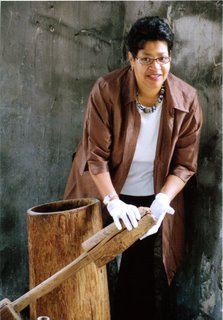SECOND REPORT ON REINTERPRETATION OF SLAVERY IN SAVANNAH

(photo of Dr. Deborah Mack by Luther Vann)
Serious explorers of culture such as the dancers Katherine Dunham and Pearl Primus, and author Zora Neale Hurston, employed the science of anthropology as an important tool in their art during the first Harlem Renaissance of the early 1900s. They not only used anthropology to identify and preserve the legacies and values of the African Diaspora, but to further validate within the United States the growing demands for equality that eventually developed into the civil rights movement.
As the present Harlem Renaissance of the New Millennium continues to progress, anthropology remains a significant tool for the identification, retrieval, and preservation of stories that define the experiences of African Americans and others who are part of the greater African Diaspora. Groups such as the Association of Black Anthropologists labor to further discover, document, and interpret the realities of black and world history. Among the leaders in this growing field is anthropologist and museum consultant Deborah L. Mack, a graduate of the University of Chicago and Northwestern University.
Working in Savannah, Georgia, with the staff of the Telfair Museum of Art’s Owens-Thomas House, Mack has helped the organization launch a project to reinterpret the history of slavery in Savannah’s famous Historic District. Educator, journalist, and historian Vaughnette Goode-Walker joined Mack on the venture as an Interpretive Project Manager. The project will provide extensive research on the lives of African Americans who lived in and interacted with the Owens-Thomas House, an elegant 18th century English Regency styled mansion that contains on its grounds one of the few remaining examples of urban slave quarters in the United States.
"This is one of the most enriching experiences of my career,” said Goode-Walker. “I feel the story, of this house and the people whose lives passed through it, has needed a voice for many years. Fortunately, I am here now to humbly guide that voice. As the pages of recorded history shout the story across centuries, all we need to do is listen."
The new Interpretive Project Manager is also author of the article on writer Nella Larsen, included in ENCYCLOPEDIA OF THE HARLEM RENAISSANCE (Facts On File).
Research performed on the Owens-Thomas House will add to the general knowledge of Savannah’s black population, both free and enslaved, during the late 1700s to the mid 1800s. The first extensive exploration of this subject occurred with the publication of Whittington B. Johnson’s groundbreaking book, “Black Savannah, 1788-1864,” in 1996. However, because urban slavery in the United States has been less documented than slavery in rural areas, the new research will help to fill a significant gap. Moreover, the intent behind this project is not simply to compile reports for intellectual elitists but to make findings available to the public through classrooms, tours, and various museums.
The first report on the reinterpretation project, which has been funded by National Endowment for Arts grants, was presented in “A Legacy Less Traveled,” an article published in the May 10, 2006, edition of CONNECT SAVANNAH . While word of the reinterpretation project took many of Savannah’s residents by surprise, many African American natives of the city in particular were stunned to learn of the urban slave quarters existence at the Owens-Thomas House. Despite the fact that thousands of visitors travel annually from all over the world to visit the site, they were simply unaware of its existence.
Aberjhani
© July 16, 2006

Comments